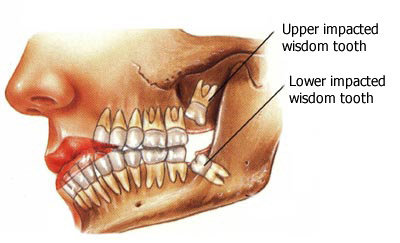
There are three molars on every quadrant of the jaw and they are meant to erupt beside each other. The first molars are the first permanent teeth to erupt in the mouth and they are followed by the second and third molars around the ages of ten and seventeen years, respectively. Since the third molars come out at very late, space is almost always compromised, so they never come out completely. Sometimes, the tooth can assume an entirely different position within the bone and tissue, and pose an even bigger problem that involves the adjacent teeth and bone structures.
This condition can cause a significant amount of discomfort for the patient including pain that extends into the jaw and ears.
Teeth Positions
Wisdom teeth are not being guided by other teeth as they erupt. Also, space is almost always compromised, and because of this, the wisdom tooth usually erupts in a different position in the mouth. Depending on the position of the tooth, the eruption can cause damage to the second molars or to the border of the lower jaw. This can make for a more difficult surgical procedure.The position of the wisdom tooth in the mouth determines the type of procedure needed. Vertically positioned wisdom teeth are much easier to remove, especially those that are found above the level of the cervical area of the second molar. Mesially or distally tipped wisdom teeth are more complicated given the inclination. Horizontally positioned teeth are more difficult to remove especially if they are positioned low and facing the end of the bone.
The Surgery
After a proper clinical diagnosis and x-ray, a surgical procedure will be scheduled and the patient will be prepared. Based on the position of the tooth, the following procedure will be followed for the surgery:Step 1: The patient is given anesthesia. Topical anesthesia is applied on the surface and then a local anesthetic is given.
Step 2: An incision is made to the gum tissue covering the area of the wisdom tooth in question and the gum is reflected, allowing a full-thickness flap.
Step 3: As soon as visibility and access is achieved, any hampering bone is removed by drilling and a sufficient area of the tooth should be exposed.
Step 4: Depending on the position, the tooth will be sectioned, so that it could be extracted from the bone that is encasing it, and fragments of the teeth will be removed, piece-by-piece.
Step 5: Once the whole tooth has been removed, the area will be cleansed of any debris and the tissue flap is replaced over the bone to cover the surgical area and then it is sutured back in place, to promote proper healing.
source: http://www.teethcenter.com/how-are-wisdom-teeth-removed/
by Teeth Center Staff
http://www.smilesbydesigninlivermore.com
No comments:
Post a Comment